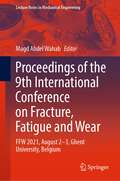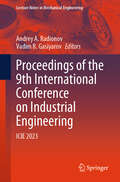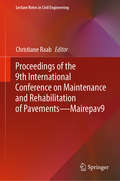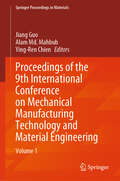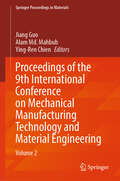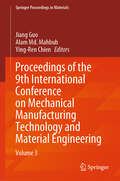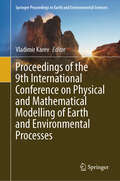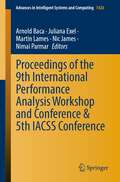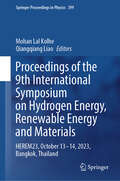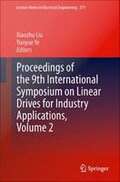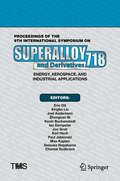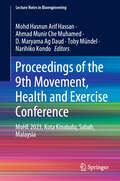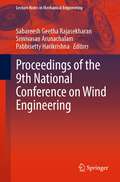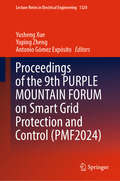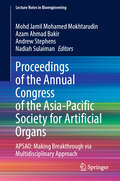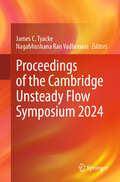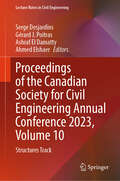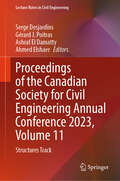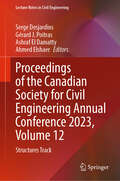- Table View
- List View
Proceedings of the 9th International Conference on Energy Engineering and Environmental Engineering (Environmental Science and Engineering)
by Zuoyu Sun Prodip DasThis book, the conference proceeding, contains invited articles and contributory papers from the 9th International Conference on Energy Engineering and Environmental Engineering, organized by Beijing Jiao Tong University in Sanya, China, on December 9–10, 2022. It includes contributions from researchers and practitioners working in the area of energy engineering, hydrogen, hydrogen carriers technology environmental engineering, climate change & global warming, and related fields. The articles cover the topics such as new energy production, storage, transmission, electrolysis, electrolyzes chemical, thermochemical, electrochemical hydrogen, energy environmental protection, and environmental sustainability. The content caters to research scholars, students, industry professionals, companies, government bodies, and policymakers, who work in the field of energy and environmental engineering.
Proceedings of the 9th International Conference on Fracture, Fatigue and Wear: FFW 2021, August 2–3, Ghent University, Belgium (Lecture Notes in Mechanical Engineering)
by Magd Abdel WahabThis proceedings gather a selection of peer-reviewed papers presented at the 9th International Conference on Fracture Fatigue and Wear (FFW 2021), held in the city of Ghent, Belgium on 2–3 August 2021. The contributions, prepared by international scientists and engineers, cover the latest advances in and innovative applications of fracture mechanics, fatigue of materials, tribology, and wear of materials. In addition, they discuss industrial applications and cover theoretical and analytical methods, numerical simulations and experimental techniques. The book is intended for academics, including graduate students and researchers, as well as industrial practitioners working in the areas of fracture fatigue and wear.
Proceedings of the 9th International Conference on Industrial Engineering: ICIE 2023 (Lecture Notes in Mechanical Engineering)
by Andrey A. Radionov Vadim R. GasiyarovThis book highlights recent findings in industrial, manufacturing and mechanical engineering and provides an overview of the state of the art in these fields, mainly in Russia and Eastern Europe. A broad range of topics and issues in modern engineering is discussed, including the machinery and mechanism design, dynamics of machines and working processes, friction, wear and lubrication in machines, design and manufacturing engineering of industrial facilities, transport and technological machines, mechanical treatment of materials, industrial hydraulic systems. This book gathers selected papers presented at the 9th International Conference on Industrial Engineering (ICIE), held in Sochi, Russia, in May 2023. The authors are experts in various fields of engineering, and all papers have been carefully reviewed. Given its scope, this book will be of interest to a wide readership, including mechanical and production engineers, lecturers in engineering disciplines, and engineering graduates.
Proceedings of the 9th International Conference on Maintenance and Rehabilitation of Pavements—Mairepav9 (Lecture Notes in Civil Engineering #76)
by Christiane RaabThis book gathers the proceedings of an international conference held at Empa (Swiss Federal Laboratories for materials Science and Technology) in Dübendorf, Switzerland, in July 2020. The conference series was established by the International Society of Maintenance and Rehabilitation of Transport Infrastructure (iSMARTi) for promoting and discussing state-of-the-art design, maintenance, rehabilitation and management of pavements. The inaugural conference was held at Mackenzie Presbyterian University in Sao Paulo, Brazil, in 2000. The series has steadily grown over the past 20 years, with installments hosted in various countries all over the world.The respective contributions share the latest insights from research and practice in the maintenance and rehabilitation of pavements, and discuss advanced materials, technologies and solutions for achieving an even more sustainable and environmentally friendly infrastructure.
Proceedings of the 9th International Conference on Mechanical Manufacturing Technology and Material Engineering: Volume 1 (Springer Proceedings in Materials #65)
by Alam Md. Mahbub Jiang Guo Ying-Ren ChienThis book offers a comprehensive examination of the latest advancements in mechanical manufacturing technology and material engineering, as presented at the 9th International Conference on Mechanical Manufacturing Technology and Material Engineering (MMTME 2024). It delves into the forefront of research in areas like additive manufacturing, smart manufacturing systems, and innovative material solutions, addressing the current gaps and technological challenges within the industry. The book is structured to highlight significant innovations that are poised to redefine manufacturing processes, enhance material performance, and drive sustainability in production. Each chapter provides in-depth analysis of emerging technologies and their practical applications, backed by recent case studies and expert insights. Key topics such as the integration of AI and IoT in manufacturing, advancements in 3D and 4D printing technologies, and the development of new sustainable materials are explored. These are critical for pushing the boundaries of what is possible in manufacturing and materials science today. This book is significant as it not only encapsulates state-of-the-art research but also provides a vision for future directions in the field. It sets out to solve problems related to efficiency, cost-effectiveness, and environmental impact in manufacturing, offering new perspectives and solutions to researchers and professionals. The target audience includes academic researchers, industry professionals, and engineers in the fields of mechanical manufacturing and material engineering.
Proceedings of the 9th International Conference on Mechanical Manufacturing Technology and Material Engineering: Volume 2 (Springer Proceedings in Materials #75)
by Alam Md. Mahbub Jiang Guo Ying-Ren ChienThis book offers a comprehensive examination of the latest advancements in mechanical manufacturing technology and material engineering, as presented at the 9th International Conference on Mechanical Manufacturing Technology and Material Engineering (MMTME 2024). It delves into the forefront of research in areas like intelligent manufacturing process and structure optimization, intelligent mechanical design and simulation analysis. The book is structured to highlight significant innovations that are poised to redefine manufacturing processes, enhance material performance, and drive sustainability in production. Each chapter provides in-depth analysis of emerging technologies and their practical applications, backed by recent case studies and expert insights. Key topics such as the integration of AI and IoT in manufacturing, advancements in 3D and 4D printing technologies, and the development of new sustainable materials are explored. These are critical for pushing the boundaries of what is possible in manufacturing and materials science today. This book is significant as it not only encapsulates state-of-the-art research but also provides a vision for future directions in the field. It sets out to solve problems related to efficiency, cost-effectiveness, and environmental impact in manufacturing, offering new perspectives and solutions to researchers and professionals. The target audience includes academic researchers, industry professionals, and engineers in the fields of mechanical manufacturing and material engineering.
Proceedings of the 9th International Conference on Mechanical Manufacturing Technology and Material Engineering: Volume 3 (Springer Proceedings in Materials #76)
by Alam Md. Mahbub Jiang Guo Ying-Ren ChienThis book offers a comprehensive examination of the latest advancements in mechanical manufacturing technology and material engineering, as presented at the 9th International Conference on Mechanical Manufacturing Technology and Material Engineering (MMTME 2024). It delves into the forefront of research in areas like intelligent mechanical system design and control, . The book is structured to highlight significant innovations that are poised to redefine manufacturing processes, enhance material performance, and drive sustainability in production. Each chapter provides in-depth analysis of emerging technologies and their practical applications, backed by recent case studies and expert insights. Key topics such as the integration of AI and IoT in manufacturing, advancements in 3D and 4D printing technologies, and the development of new sustainable materials are explored. These are critical for pushing the boundaries of what is possible in manufacturing and materials science today. This book is significant as it not only encapsulates state-of-the-art research but also provides a vision for future directions in the field. It sets out to solve problems related to efficiency, cost-effectiveness, and environmental impact in manufacturing, offering new perspectives and solutions to researchers and professionals. The target audience includes academic researchers, industry professionals, and engineers in the fields of mechanical manufacturing and material engineering.
Proceedings of the 9th International Conference on Physical and Mathematical Modelling of Earth and Environmental Processes (Springer Proceedings in Earth and Environmental Sciences)
by Vladimir KarevThis book presents short papers of participants of the 9th International Scientific Conference-School for Young Scientists «Physical and Mathematical Modeling of Earth and Environment Processes. A special focus is given to the extraction of hydrocarbon resources, including from unconventional sources. An alternative to the use of hydrocarbons as a main source of energy on the Planet in the coming decades is unlikely to be found. At the same time, the resource base of hydrocarbons is quickly depleted, in particularly, large and accessible oil and gas fields. The shale oil and gas, Arctic hydrocarbon stocks, gas hydrates, coal bed methane, oil and gas from deep horizons can become new sources. "Deep oil" may be the most promising source of expanding the resource base of hydrocarbons according to many experts. New technologies are required to their development. Efficient low-cost technologies can be created on the basis of geomechanical approach, i.e., through the use of a huge elastic energy stored in the rock massif due to rock pressure. The creation of new breakthrough approaches to the development of hydrocarbon fields is very important in today's geopolitical conditions and requires the involvement of young minds and strength. International activities, including the youth scientific schools, can become an effective tool for exchange of information and the organizing of interdisciplinary research of processes in geo-environment. The book presents the new results of the experimental and theoretical modeling of deformation, fracture, and filtration processes in the rocks in connection to issues of creating scientific fundamentals for new hydrocarbon production technologies. The investigations of the dependence of well stability and permeability of rocks on the stress-strain state in conditions of deep horizons and high rock pressure are also represented.
Proceedings of the 9th International Ergonomics Conference: ERGONOMICS 2022 (Lecture Notes in Networks and Systems #701)
by Davor Sumpor Kristian Jambrošić Tanja Jurčević Lulić Ivana Salopek Čubrić Goran ČubrićThis book presents the proceedings of the 9th International Ergonomics Conference (ERGONOMICS), held in Zagreb, Croatia, on December 7–10, 2022. By highlighting the latest theories and models, as well as cutting-edge technologies and applications, and by combining findings from a range of disciplines including engineering, design, robotics, health care, management, computer science, human biology, and behavioral science, it provides researchers and practitioners alike with a comprehensive, timely guide on human factors and ergonomics. It also offers an excellent source of innovative ideas to stimulate future discussions and developments aimed at applying knowledge and techniques to optimize system performance, while at the same time promoting the health, safety, and well-being of individuals. The proceedings includes papers from researchers and practitioners, scientists and physicians, institutional leaders, managers, and policy makers that contribute to constructing the human factors and ergonomics approach across a variety of methodologies, domains, and productive sectors.
Proceedings of the 9th International Performance Analysis Workshop and Conference & 5th IACSS Conference (Advances in Intelligent Systems and Computing #1426)
by Martin Lames Arnold Baca Juliana Exel Nic James Nimai ParmarThis covers the PACSS 2021 which approached interdisciplinary collaboration between theoretical computer science and practical performance analysis though an online workshop and conference. Readers find in this book the peer-reviewed and discussed evidences on how computer scientists and performance analysts can and have worked together to solve both applied and research-based problems in elite sport, using the methods of computer science. In this edition, we organize the content according to four major topics: machine learning, text mining, best practice and interdisciplinary collaboration. This is a refined material written by leading experts with up-to-date overview of research in the multidisciplinary field of computer science and elite sport performance analysis.
Proceedings of the 9th International Symposium on Hydrogen Energy, Renewable Energy and Materials: HEREM23, October 13 –14, 2023, Bangkok, Thailand (Springer Proceedings in Physics #399)
by Mohan Lal Kolhe Qiangqiang LiaoSpringer Proceedings in Physics publishes the latest research from the 9th International Symposium on Hydrogen Energy, Renewable Energy and Materials. This comprehensive collection explores cutting-edge theory, modelling, experimentation, and practical applications in hydrogen energy, renewable sources, and advanced materials. Readers will be able to gain insights into critical areas like hydrogen production, storage, and utilization; solar, wind, bioenergy, and use of waste materials; and next-generation materials for fuel cells, batteries, and photovoltaics. This indispensable resource provides researchers, developers, and policymakers with the knowledge they need to accelerate the path to a sustainable future.
Proceedings of the 9th International Symposium on Linear Drives for Industry Applications, Volume 1
by Xiaozhu Liu Yunyue YeThe 9th International Symposium on Linear Drives for Industry Applications (LDIA 2013) was held on July 7-10, 2013 in Hangzhou, China. The LDIA 2013 was organized by Zhejiang University, a leading comprehensive university in China, and offered a venue for leading academic and industrial researchers to exchange their views, ideas and findings on innovative technologies and sustainable solutions leading to linear drivers and intelligence applications. The conference featured keynote speakers, a panel discussion and paper presentations. The objective of the LDIA 2013 is to facilitate the exchange of information on best practices and to profile the latest research advances in the areas of linear drive technologies, control theory, information engineering, control engineering and intelligence applications, which mainly concern the fields of Engineering and Computer Science, Informatics, Communications and Control etc. The proceedings are intended for scientists, engineers and graduate students in Engineering and Computer Science, especially those focusing on linear drives.
Proceedings of the 9th International Symposium on Linear Drives for Industry Applications, Volume 2
by Xiaozhu Liu Yunyue YeThe 9th International Symposium on Linear Drives for Industry Applications (LDIA 2013) was held on July 7-10, 2013 in Hangzhou, China. The LDIA 2013 was organized by Zhejiang University, a leading comprehensive university in China, and offered a venue for leading academic and industrial researchers to exchange their views, ideas and findings on innovative technologies and sustainable solutions leading to linear drivers and intelligence applications. The conference featured keynote speakers, a panel discussion and paper presentations. The objective of the LDIA 2013 is to facilitate the exchange of information on best practices and to profile the latest research advances in the areas of linear drive technologies, control theory, information engineering, control engineering and intelligence applications, which mainly concern the fields of Engineering and Computer Science, Informatics, Communications and Control etc. The proceedings are intended for scientists, engineers and graduate students in Engineering and Computer Science, especially those focusing on linear drives.
Proceedings of the 9th International Symposium on Linear Drives for Industry Applications, Volume 3
by Xiaozhu Liu Yunyue YeThe 9th International Symposium on Linear Drives for Industry Applications (LDIA 2013) was held on July 7-10, 2013 in Hangzhou, China. The LDIA 2013 was organized by Zhejiang University, a leading comprehensive university in China, and offered a venue for leading academic and industrial researchers to exchange their views, ideas and findings on innovative technologies and sustainable solutions leading to linear drivers and intelligence applications. The conference featured keynote speakers, a panel discussion and paper presentations. The objective of the LDIA 2013 is to facilitate the exchange of information on best practices and to profile the latest research advances in the areas of linear drive technologies, control theory, information engineering, control engineering and intelligence applications, which mainly concern the fields of Engineering and Computer Science, Informatics, Communications and Control etc. The proceedings are intended for scientists, engineers and graduate students in Engineering and Computer Science, especially those focusing on linear drives.
Proceedings of the 9th International Symposium on Linear Drives for Industry Applications, Volume 4
by Xiaozhu Liu Yunyue YeThe 9th International Symposium on Linear Drives for Industry Applications (LDIA 2013) was held on July 7-10, 2013 in Hangzhou, China. The LDIA 2013 was organized by Zhejiang University, a leading comprehensive university in China, and offered a venue for leading academic and industrial researchers to exchange their views, ideas and findings on innovative technologies and sustainable solutions leading to linear drivers and intelligence applications. The conference featured keynote speakers, a panel discussion and paper presentations. The objective of the LDIA 2013 is to facilitate the exchange of information on best practices and to profile the latest research advances in the areas of linear drive technologies, control theory, information engineering, control engineering and intelligence applications, which mainly concern the fields of Engineering and Computer Science, Informatics, Communications and Control etc. The proceedings are intended for scientists, engineers and graduate students in Engineering and Computer Science, especially those focusing on linear drives.
Proceedings of the 9th International Symposium on Superalloy 718 & Derivatives: Energy, Aerospace, and Industrial Applications (The Minerals, Metals & Materials Series)
by Xingbo Liu Eric Ott Joel Andersson Zhongnan Bi Kevin Bockenstedt Ian Dempster Jon Groh Karl Heck Paul Jablonski Max Kaplan Daisuke Nagahama Chantal SudbrackThis technical meeting will focus on Alloy 718 and Superalloys in this class relative to alloy and process development, production, product applications, trends and the development of advanced modeling tools. The symposium provides an opportunity for authors to present technical advancements relative to a broad spectrum of areas while assessing their impact on related fields associated with this critical alloy group. There are continuing innovations relative to these alloys as well as novel processing techniques which continue to extend applications in very challenging environments ranging from corrosion resistance in the deep sea to high-stressed space applications.
Proceedings of the 9th Movement, Health and Exercise Conference: MoHE 2023, Kota Kinabalu, Sabah, Malaysia (Lecture Notes in Bioengineering)
by Mohd Hasnun Arif Hassan Ahmad Munir Che Muhamed D. Maryama Ag Daud Toby Mündel Narihiko KondoThis book gathers papers presented at the 9th International Conference of Movement, Health and Exercise (MoHE 2023) held at Kota Kinabalu, Sabah, Malaysia. The content covers the following topics: exercise science; human performance; physical activity & health; sports medicine; sports nutrition; management & sports studies; and sports engineering & technology. The articles published will be of interest to researchers and practitioners from the field of rehabilitation, exercise medicine and sports technology.
Proceedings of the 9th National Conference on Wind Engineering (Lecture Notes in Mechanical Engineering)
by Sabareesh Geetha Rajasekharan Srinivasan Arunachalam Pabbisetty HarikrishnaThe book presents the select proceedings of 9th National Conference on Wind Engineering. It covers the latest technology and research in the areas of wind engineering and wind energy technologies. Various topics covered in this book are wind-resistant design of structures, climate modeling, applications of artificial intelligence and machine learning in fluid mechanics, novel ways to increase the efficiency of wind energy harnessing, characterization of airfoils, modern wind turbine designs and computational wind engineering studies. This book is useful for researchers and professionals in the areas of structural design, wind energy, wind engineering, renewable energy and fluid mechanics.
Proceedings of the 9th PURPLE MOUNTAIN FORUM on Smart Grid Protection and Control (Lecture Notes in Electrical Engineering #1320)
by Yusheng Xue Yuping Zheng Antonio Gómez ExpósitoThis book includes original, peer-reviewed research papers from the 2024 Engineering Technology Forum of CAE & the 9th Purple Mountain Form on Smart Grid Protection and Control(PMF2024), held in Nanjing, China, on August 16-18, 2024. The accepted papers cover the following topics: 1. Advanced power transmission technology 2. AC/DC hybrid power grid technology 3. Power Internet of Things Technology and Application 4. Operation, control and protection of smart grid 5. Active distribution network technology 6. Power electronic technology and application 7. New technology of substation automation 8. Energy storage technology and application 9. Application of new technologies such as artificial intelligence, blockchain, and big data 10. Application of Information and Communication Technology 11. Low-carbon energy planning and security 12. Low-carbon operation of the power system 13. Low-carbon energy comprehensive utilization technology 14. Carbon trading and power market 15. Carbon emission stream and carbon capture technology 16. Energy saving and smart energy technology 17. Analysis and evaluation of low-carbon efficiency of power system 18. Carbon flow modelling in power system operation The papers included in this proceeding share the latest research results and practical application examples on the methodologies and algorithms in these areas, which makes the book a valuable reference for researchers, engineers, and university students.
Proceedings of the American Solar Energy Society National Conference: ASES SOLAR 2022 (Springer Proceedings in Energy)
by Ashok Kumar Ghosh Carly RixhamThis book focuses on the complex topic of “Energy Transition with Economic Justice” and highlights research presented during the American Solar Energy Society’s National Solar Conference (ASES SOLAR 2022) held at the University of New Mexico. This conference brings together a broad base of solar and renewable energy professionals and thought leaders, including researchers, architects, engineers, entrepreneurs, installers, manufacturers, economists, finance professionals, and policy makers, and provides a platform for the exchange of ideas, information and business insights and unbiased perspectives on progress toward greater sustainability. The conference papers explore interests of shared values and identify contentious issues in the transition towards 100% renewable energy in the United States, especially on public lands, within tribal communities, and frontier areas.
Proceedings of the Annual Congress of the Asia-Pacific Society for Artificial Organs: APSAO: Making Breakthrough via Multidisciplinary Approach (Lecture Notes in Bioengineering)
by Mohd Jamil Mohamed Mokhtarudin Azam Ahmad Bakir Andrew Stephens Nadiah SulaimanThis book presents the proceedings of the Annual Congress of the Asia-Pacific Society for Artificial Organs (APSAO) 2023, which focuses on multidisciplinary advances and innovations in the cardiovascular, respiratory, and renal support systems. This collection of articles covers three main themes that are closely related to advances in artificial organs: (i) digital health and numerical simulation (ii) Design, development, evaluation and clinical translation and (iii) Biomaterials and tissue engineering. The conference showcased speakers from different countries in the Asia-Pacific region presenting their cutting-edge research on the designs, development, and evaluation of the cardiovascular, respiratory, and renal support systems. In addition, the readers are expected to gain an insightful view on the current needs for artificial organs research and development, as well as the steps needed for successful translation from concept into clinical practices. Specifically, the book willdeliberate the key challenges associated with the design and development of artificial organs, their clinical translation as well as patient management in the Asia-Pacific region, particularly in the low- and middle-income countries.
Proceedings of the Cambridge Unsteady Flow Symposium 2024
by James C. Tyacke Nagabhushana Rao VadlamaniThis book contains the proceedings of the Cambridge Unsteady Flow Symposium, held on 4–5 March 2024 at the University of Cambridge. The book brings together internationally leading experts in computational fluid dynamics (CFD) and promotes discussions on numerical methods for unsteady flows. The book covers a wide range of topics related to CFD, including but not limited to, large-eddy simulations, unsteady flows in aerospace, high order methods, and mesh generation.
Proceedings of the Canadian Society for Civil Engineering Annual Conference 2023, Volume 10: Structures Track (Lecture Notes in Civil Engineering #504)
by Ashraf El Damatty Serge Desjardins Gérard J. Poitras Ahmed ElshaerThis book comprises the proceedings of the Annual Conference of the Canadian Society for Civil Engineering 2023. The contents of this volume focus on the specialty track in structural engineering with topics on bridge design, FRP concrete structures, innovation in structural engineering, seismic analysis and design, wind load on structures, masonry structures, structural optimization, machine learning and AI in structural engineering, and wood and timber structures, among others. This volume will prove a valuable resource for researchers and professionals.
Proceedings of the Canadian Society for Civil Engineering Annual Conference 2023, Volume 11: Structures Track (Lecture Notes in Civil Engineering #505)
by Ashraf El Damatty Serge Desjardins Gérard J. Poitras Ahmed ElshaerThis book comprises the proceedings of the Annual Conference of the Canadian Society for Civil Engineering 2023. The contents of this volume focus on the specialty track in structural engineering with topics on bridge design, FRP concrete structures, innovation in structural engineering, seismic analysis and design, wind load on structures, masonry structures, structural optimization, machine learning and AI in structural engineering, and wood and timber structures, among others. This volume will prove a valuable resource for researchers and professionals.
Proceedings of the Canadian Society for Civil Engineering Annual Conference 2023, Volume 12: Structures Track (Lecture Notes in Civil Engineering #506)
by Ashraf El Damatty Serge Desjardins Gérard J. Poitras Ahmed ElshaerThis book comprises the proceedings of the Annual Conference of the Canadian Society for Civil Engineering 2023. The contents of this volume focus on the specialty track in structural engineering with topics on bridge design, FRP concrete structures, innovation in structural engineering, seismic analysis and design, wind load on structures, masonry structures, structural optimization, machine learning and AI in structural engineering, and wood and timber structures, among others. This volume will prove a valuable resource for researchers and professionals.

